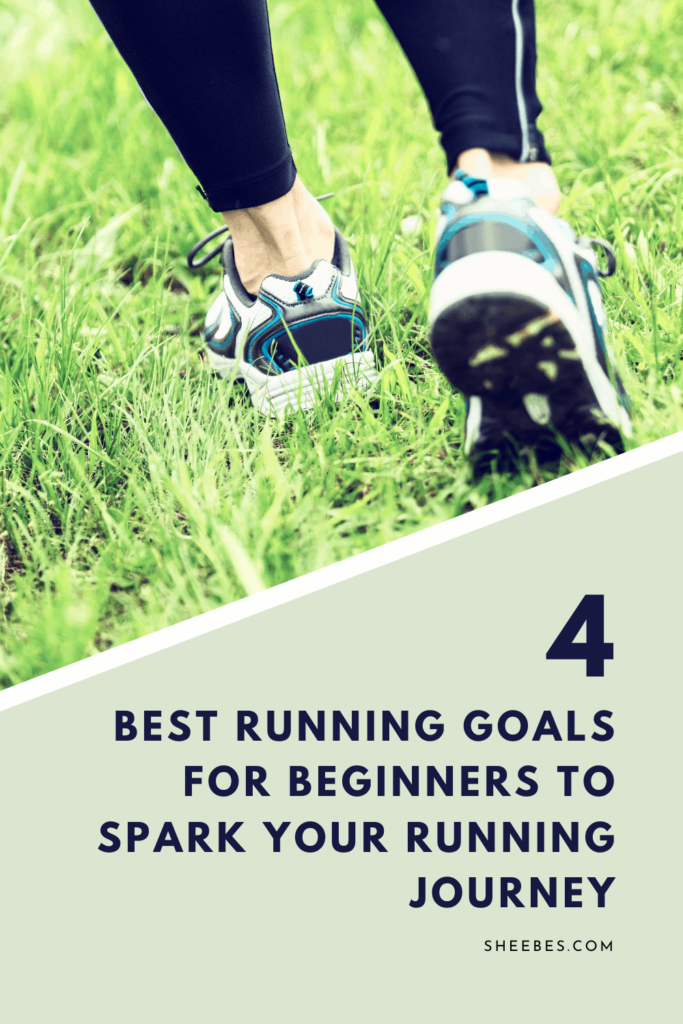If you aim to go from non-runner to new runner, you may wonder, “what are the best running goals for beginners like me?”.
Running goals channel your energy and focus.
But set a goal too high, and you unintentionally set yourself up to drown in frustration and disappointment. Set a running goal too low, and you sink into boredom because it’s too easy.
How do you choose a running goal that strikes the right balance?
Here we’ll narrow it down to the 4 best running goals for beginners like you.
These are the goals designed to ease and motivate you into running regularly so you can transform from non-runner to new runner in no time.

Whether you’re a runner looking for running tips or a cyclist searching for cycling advice, this site is here to help you elevate your fitness game.
Affiliate Disclosure: I’m here to help you grow as a rider and runner. So to keep things running smoothly and the content free, I participate in the Amazon Services program and select affiliate networks. So, when you click on those affiliate links, I earn a small commission at no extra cost to you.

Do a 3 month walk-run 1 program
You might believe that walking has no place in a runner’s repertoire, but walk breaks benefit both beginner runners and veteran runners.
As you run, your body absorbs roughly 2.5 to 3 times its body weight with every stride.
If you stand up on both legs, you have half your body weight on each leg.
And if you stand on one leg, that’s 100% of your body weight on one leg.
Now take a barbell, add about 150% of your body weight to it, and hoist the load up and onto your shoulders; then stand on one leg.
Like it or not, this is how much stress your bones, tendons, muscles, cartilage, and ligaments support with every single stride you take.
If you’re new to running, walking is one of the best things you can do to build fitness, endurance, and strength without overloading your system.
And as you build your running ability, walk breaks can delay muscle fatigue so you can run faster, and longer. 2
A 3-month walk-run program lays the foundation for more running.
And it:
- Helps you build a running habit
- Strengthens your bones, muscles, and tendons gradually
- Improves your endurance
- Reduces your injury risk
Want to learn more about the run walk method? You’ll find it here: The Run Walk Run Method, Jeff Galloway.

Run 3 times a week, every other day
If you envision yourself running farther and faster, then we’ve got to do the groundwork today to help you get there—by running regularly.
Running three times a week as a new runner helps you alternate between stress (running) and rest, so you never get overwhelmed, burnt out, or bored.
You’ll build your endurance steadily while avoiding one of the major mistakes many runners fall into—the trap of too much, too soon.
But carving out time to run three times a week is easier said than done and can throw a wrench into an already busy schedule.
You could try scheduling your runs on your calendar. Or, you could try making it into a game to see how many weeks you can stick with it.
But even with the best running routines, life happens, and running gets pushed onto the back burner.
And that’s okay because running isn’t an all-or-nothing endeavor. Your running routine can be flexible, and you can return to running at any time and begin again.
Running isn’t an all-or-nothing endeavor. You can return to it at any time and begin again.
The good news is, when you return to your running routine, you won’t be starting over as a brand new runner. This time, you’ll have miles and experience under your belt.

Do a strength training routine once a week
You might have heard that runners run, but did you know that runners also lift? Not just in the weight room, but as you’re running—you’re lifting weights every time you run.
With every stride, you’re lifting yourself into the air, propelling your body forward, and absorbing force when you land. And to do all of that, you have to be incredibly strong and stable.
It’s true—running builds strength—in the muscles that drive the body forward.
We often neglect the muscles that help us move in other directions—that is, the muscles that help us move sideways (side steps) and rotationally (swinging a bat).
To be a well-rounded, injury-resistant runner, you need to move forward, sideways, and rotationally.
This ability is invaluable if you plan to run on trails, where you’d have to sidestep rocks, roots, and more.

Finish your first 5k
As a new runner, training for a 5k—3.1 miles—can take anywhere from 8 to 12 weeks, depending on your current fitness. (You’ll find 5k training plans for beginners here.)
And it can be considered one of the best running goals for beginners because:
- It’s a goal with a deadline that gives you a persuasive reason to step out the door.
- You can train for this race even if you’re busy since it doesn’t demand a hefty time investment.
- It will build your endurance and mental strength because this will nudge you out of your comfort zone.
- Crossing that finish line might light the fire to keep running.
This running goal is about crossing the finish line of your first 5K—walking, running, or a combination of both, not about a fast finish time.
This goal here is to improve and progress your running. But don’t worry, there’s plenty of time for time goals later.
A regular running routine lays the foundation for your future running goals, but it’s not always easy. That’s why I’ve created a free workbook to guide you through creating a new running habit.
Sign up now to snag this freebie that will help you establish a regular running routine.
Grab it now!

Sources
- How long does it take for a habit to take hold? In this study of habit formation, researchers found that it takes an average of 66 days for a habit to stick. Habit still not sticking? Hang in there; researchers found it can take anywhere from 18 days to 254 days to form a new habit, depending on the person. ↩
- Does a walk/ run strategy decrease cardiac stress during a marathon in non-elite runners? ↩